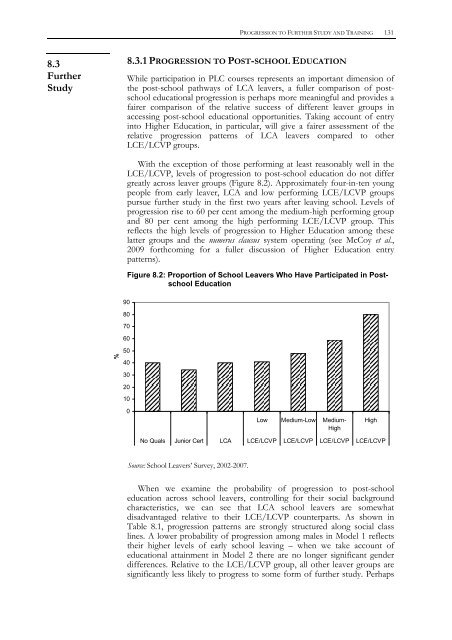Student Experiences of the Leaving Certificate Applied Programme
Student Experiences of the Leaving Certificate Applied Programme
Student Experiences of the Leaving Certificate Applied Programme
Create successful ePaper yourself
Turn your PDF publications into a flip-book with our unique Google optimized e-Paper software.
PROGRESSION TO FURTHER STUDY AND TRAINING 1318.3Fur<strong>the</strong>rStudy8.3.1 PROGRESSION TO POST-SCHOOL EDUCATIONWhile participation in PLC courses represents an important dimension <strong>of</strong><strong>the</strong> post-school pathways <strong>of</strong> LCA leavers, a fuller comparison <strong>of</strong> postschooleducational progression is perhaps more meaningful and provides afairer comparison <strong>of</strong> <strong>the</strong> relative success <strong>of</strong> different leaver groups inaccessing post-school educational opportunities. Taking account <strong>of</strong> entryinto Higher Education, in particular, will give a fairer assessment <strong>of</strong> <strong>the</strong>relative progression patterns <strong>of</strong> LCA leavers compared to o<strong>the</strong>rLCE/LCVP groups.With <strong>the</strong> exception <strong>of</strong> those performing at least reasonably well in <strong>the</strong>LCE/LCVP, levels <strong>of</strong> progression to post-school education do not differgreatly across leaver groups (Figure 8.2). Approximately four-in-ten youngpeople from early leaver, LCA and low performing LCE/LCVP groupspursue fur<strong>the</strong>r study in <strong>the</strong> first two years after leaving school. Levels <strong>of</strong>progression rise to 60 per cent among <strong>the</strong> medium-high performing groupand 80 per cent among <strong>the</strong> high performing LCE/LCVP group. Thisreflects <strong>the</strong> high levels <strong>of</strong> progression to Higher Education among <strong>the</strong>selatter groups and <strong>the</strong> numerus clausus system operating (see McCoy et al.,2009 forthcoming for a fuller discussion <strong>of</strong> Higher Education entrypatterns).Figure 8.2: Proportion <strong>of</strong> School Leavers Who Have Participated in PostschoolEducation%9080706050403020100LowMedium-LowMedium-HighHighNo Quals Junior Cert LCA LCE/LCVP LCE/LCVP LCE/LCVP LCE/LCVPSource: School Leavers’ Survey, 2002-2007.When we examine <strong>the</strong> probability <strong>of</strong> progression to post-schooleducation across school leavers, controlling for <strong>the</strong>ir social backgroundcharacteristics, we can see that LCA school leavers are somewhatdisadvantaged relative to <strong>the</strong>ir LCE/LCVP counterparts. As shown inTable 8.1, progression patterns are strongly structured along social classlines. A lower probability <strong>of</strong> progression among males in Model 1 reflects<strong>the</strong>ir higher levels <strong>of</strong> early school leaving – when we take account <strong>of</strong>educational attainment in Model 2 <strong>the</strong>re are no longer significant genderdifferences. Relative to <strong>the</strong> LCE/LCVP group, all o<strong>the</strong>r leaver groups aresignificantly less likely to progress to some form <strong>of</strong> fur<strong>the</strong>r study. Perhaps

















